Wenchao Xu
Sherman
Deploying Foundation Model Powered Agent Services: A Survey
Dec 18, 2024



Abstract:Foundation model (FM) powered agent services are regarded as a promising solution to develop intelligent and personalized applications for advancing toward Artificial General Intelligence (AGI). To achieve high reliability and scalability in deploying these agent services, it is essential to collaboratively optimize computational and communication resources, thereby ensuring effective resource allocation and seamless service delivery. In pursuit of this vision, this paper proposes a unified framework aimed at providing a comprehensive survey on deploying FM-based agent services across heterogeneous devices, with the emphasis on the integration of model and resource optimization to establish a robust infrastructure for these services. Particularly, this paper begins with exploring various low-level optimization strategies during inference and studies approaches that enhance system scalability, such as parallelism techniques and resource scaling methods. The paper then discusses several prominent FMs and investigates research efforts focused on inference acceleration, including techniques such as model compression and token reduction. Moreover, the paper also investigates critical components for constructing agent services and highlights notable intelligent applications. Finally, the paper presents potential research directions for developing real-time agent services with high Quality of Service (QoS).
Unleashing the Power of Continual Learning on Non-Centralized Devices: A Survey
Dec 18, 2024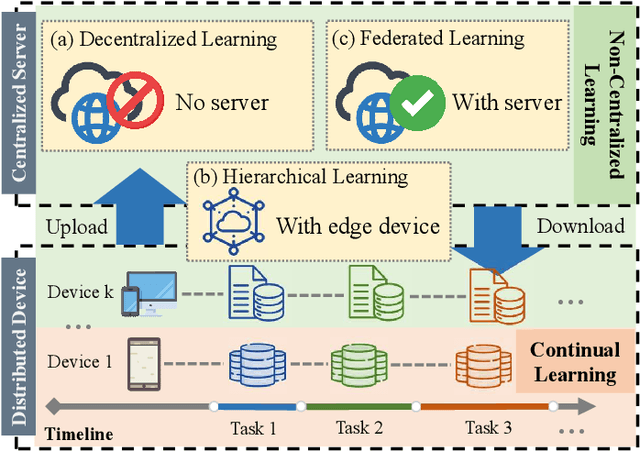
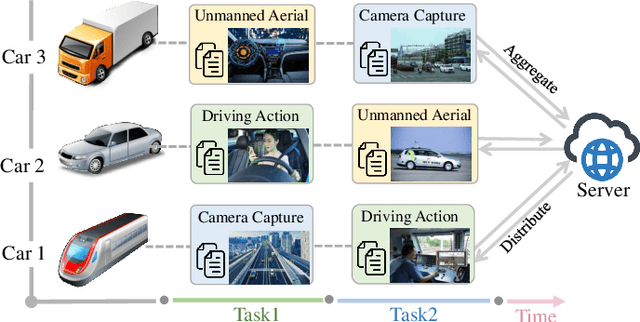
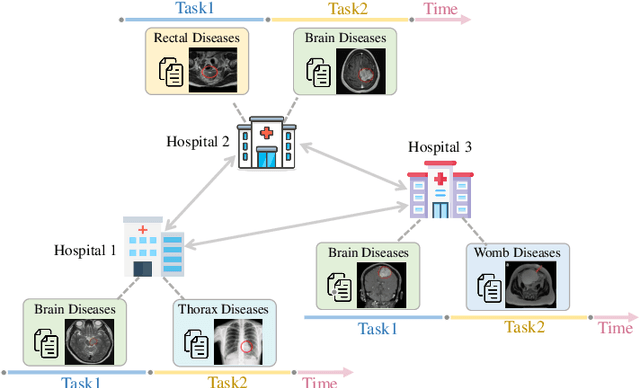
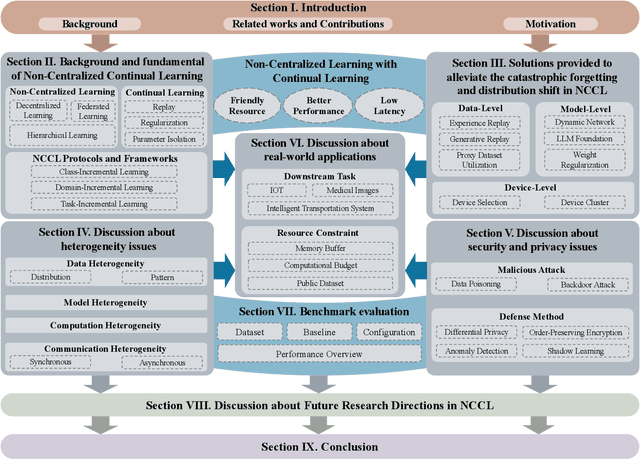
Abstract:Non-Centralized Continual Learning (NCCL) has become an emerging paradigm for enabling distributed devices such as vehicles and servers to handle streaming data from a joint non-stationary environment. To achieve high reliability and scalability in deploying this paradigm in distributed systems, it is essential to conquer challenges stemming from both spatial and temporal dimensions, manifesting as distribution shifts, catastrophic forgetting, heterogeneity, and privacy issues. This survey focuses on a comprehensive examination of the development of the non-centralized continual learning algorithms and the real-world deployment across distributed devices. We begin with an introduction to the background and fundamentals of non-centralized learning and continual learning. Then, we review existing solutions from three levels to represent how existing techniques alleviate the catastrophic forgetting and distribution shift. Additionally, we delve into the various types of heterogeneity issues, security, and privacy attributes, as well as real-world applications across three prevalent scenarios. Furthermore, we establish a large-scale benchmark to revisit this problem and analyze the performance of the state-of-the-art NCCL approaches. Finally, we discuss the important challenges and future research directions in NCCL.
Boosting Fine-Grained Visual Anomaly Detection with Coarse-Knowledge-Aware Adversarial Learning
Dec 17, 2024Abstract:Many unsupervised visual anomaly detection methods train an auto-encoder to reconstruct normal samples and then leverage the reconstruction error map to detect and localize the anomalies. However, due to the powerful modeling and generalization ability of neural networks, some anomalies can also be well reconstructed, resulting in unsatisfactory detection and localization accuracy. In this paper, a small coarsely-labeled anomaly dataset is first collected. Then, a coarse-knowledge-aware adversarial learning method is developed to align the distribution of reconstructed features with that of normal features. The alignment can effectively suppress the auto-encoder's reconstruction ability on anomalies and thus improve the detection accuracy. Considering that anomalies often only occupy very small areas in anomalous images, a patch-level adversarial learning strategy is further developed. Although no patch-level anomalous information is available, we rigorously prove that by simply viewing any patch features from anomalous images as anomalies, the proposed knowledge-aware method can also align the distribution of reconstructed patch features with the normal ones. Experimental results on four medical datasets and two industrial datasets demonstrate the effectiveness of our method in improving the detection and localization performance.
A QoE-Aware Split Inference Accelerating Algorithm for NOMA-based Edge Intelligence
Sep 25, 2024
Abstract:Even the AI has been widely used and significantly changed our life, deploying the large AI models on resource limited edge devices directly is not appropriate. Thus, the model split inference is proposed to improve the performance of edge intelligence, in which the AI model is divided into different sub models and the resource-intensive sub model is offloaded to edge server wirelessly for reducing resource requirements and inference latency. However, the previous works mainly concentrate on improving and optimizing the system QoS, ignore the effect of QoE which is another critical item for the users except for QoS. Even the QoE has been widely learned in EC, considering the differences between task offloading in EC and split inference in EI, and the specific issues in QoE which are still not addressed in EC and EI, these algorithms cannot work effectively in edge split inference scenarios. Thus, an effective resource allocation algorithm is proposed in this paper, for accelerating split inference in EI and achieving the tradeoff between inference delay, QoE, and resource consumption, abbreviated as ERA. Specifically, the ERA takes the resource consumption, QoE, and inference latency into account to find the optimal model split strategy and resource allocation strategy. Since the minimum inference delay and resource consumption, and maximum QoE cannot be satisfied simultaneously, the gradient descent based algorithm is adopted to find the optimal tradeoff between them. Moreover, the loop iteration GD approach is developed to reduce the complexity of the GD algorithm caused by parameter discretization. Additionally, the properties of the proposed algorithms are investigated, including convergence, complexity, and approximation error. The experimental results demonstrate that the performance of ERA is much better than that of the previous studies.
FedBAT: Communication-Efficient Federated Learning via Learnable Binarization
Aug 06, 2024



Abstract:Federated learning is a promising distributed machine learning paradigm that can effectively exploit large-scale data without exposing users' privacy. However, it may incur significant communication overhead, thereby potentially impairing the training efficiency. To address this challenge, numerous studies suggest binarizing the model updates. Nonetheless, traditional methods usually binarize model updates in a post-training manner, resulting in significant approximation errors and consequent degradation in model accuracy. To this end, we propose Federated Binarization-Aware Training (FedBAT), a novel framework that directly learns binary model updates during the local training process, thus inherently reducing the approximation errors. FedBAT incorporates an innovative binarization operator, along with meticulously designed derivatives to facilitate efficient learning. In addition, we establish theoretical guarantees regarding the convergence of FedBAT. Extensive experiments are conducted on four popular datasets. The results show that FedBAT significantly accelerates the convergence and exceeds the accuracy of baselines by up to 9\%, even surpassing that of FedAvg in some cases.
Self-Introspective Decoding: Alleviating Hallucinations for Large Vision-Language Models
Aug 04, 2024Abstract:While Large Vision-Language Models (LVLMs) have rapidly advanced in recent years, the prevalent issue known as the `hallucination' problem has emerged as a significant bottleneck, hindering their real-world deployments. Existing methods mitigate this issue mainly from two perspectives: One approach leverages extra knowledge like robust instruction tuning LVLMs with curated datasets or employing auxiliary analysis networks, which inevitable incur additional costs. Another approach, known as contrastive decoding, induces hallucinations by manually disturbing the vision or instruction raw inputs and mitigates them by contrasting the outputs of the disturbed and original LVLMs. However, these approaches rely on empirical holistic input disturbances and double the inference cost. To avoid these issues, we propose a simple yet effective method named Self-Introspective Decoding (SID). Our empirical investigation reveals that pretrained LVLMs can introspectively assess the importance of vision tokens based on preceding vision and text (both instruction and generated) tokens. We develop the Context and Text-aware Token Selection (CT2S) strategy, which preserves only unimportant vision tokens after early layers of LVLMs to adaptively amplify text-informed hallucination during the auto-regressive decoding. This approach ensures that multimodal knowledge absorbed in the early layers induces multimodal contextual rather than aimless hallucinations. Subsequently, the original token logits subtract the amplified vision-and-text association hallucinations, guiding LVLMs decoding faithfully. Extensive experiments illustrate SID generates less-hallucination and higher-quality texts across various metrics, without extra knowledge and much additional computation burdens.
Detached and Interactive Multimodal Learning
Jul 28, 2024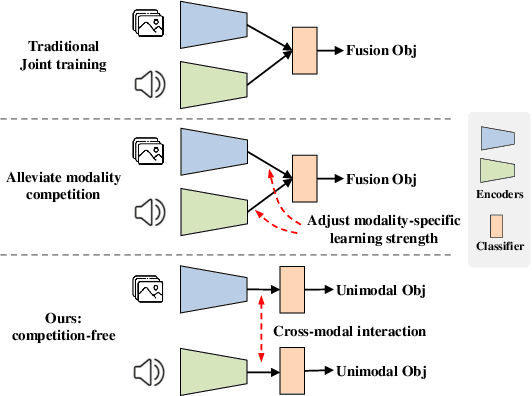

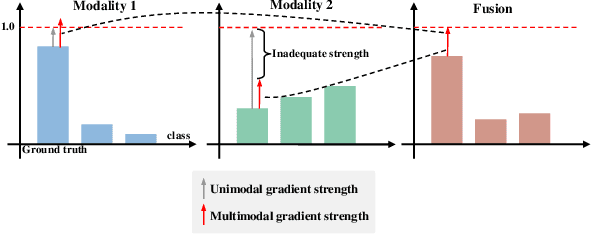

Abstract:Recently, Multimodal Learning (MML) has gained significant interest as it compensates for single-modality limitations through comprehensive complementary information within multimodal data. However, traditional MML methods generally use the joint learning framework with a uniform learning objective that can lead to the modality competition issue, where feedback predominantly comes from certain modalities, limiting the full potential of others. In response to this challenge, this paper introduces DI-MML, a novel detached MML framework designed to learn complementary information across modalities under the premise of avoiding modality competition. Specifically, DI-MML addresses competition by separately training each modality encoder with isolated learning objectives. It further encourages cross-modal interaction via a shared classifier that defines a common feature space and employing a dimension-decoupled unidirectional contrastive (DUC) loss to facilitate modality-level knowledge transfer. Additionally, to account for varying reliability in sample pairs, we devise a certainty-aware logit weighting strategy to effectively leverage complementary information at the instance level during inference. Extensive experiments conducted on audio-visual, flow-image, and front-rear view datasets show the superior performance of our proposed method. The code is released at https://github.com/fanyunfeng-bit/DI-MML.
ST-Mamba: Spatial-Temporal Mamba for Traffic Flow Estimation Recovery using Limited Data
Jul 11, 2024Abstract:Traffic flow estimation (TFE) is crucial for urban intelligent traffic systems. While traditional on-road detectors are hindered by limited coverage and high costs, cloud computing and data mining of vehicular network data, such as driving speeds and GPS coordinates, present a promising and cost-effective alternative. Furthermore, minimizing data collection can significantly reduce overhead. However, limited data can lead to inaccuracies and instability in TFE. To address this, we introduce the spatial-temporal Mamba (ST-Mamba), a deep learning model combining a convolutional neural network (CNN) with a Mamba framework. ST-Mamba is designed to enhance TFE accuracy and stability by effectively capturing the spatial-temporal patterns within traffic flow. Our model aims to achieve results comparable to those from extensive data sets while only utilizing minimal data. Simulations using real-world datasets have validated our model's ability to deliver precise and stable TFE across an urban landscape based on limited data, establishing a cost-efficient solution for TFE.
Spatial-Temporal Attention Model for Traffic State Estimation with Sparse Internet of Vehicles
Jul 10, 2024
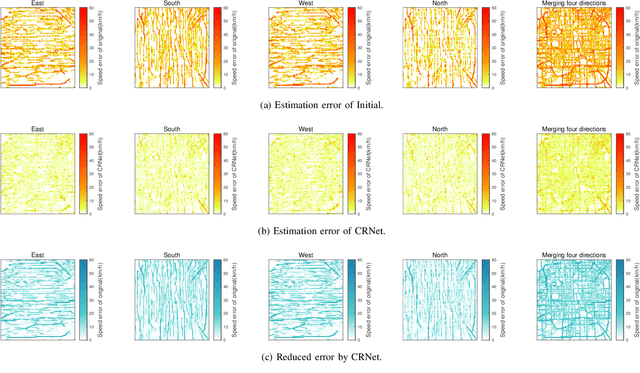
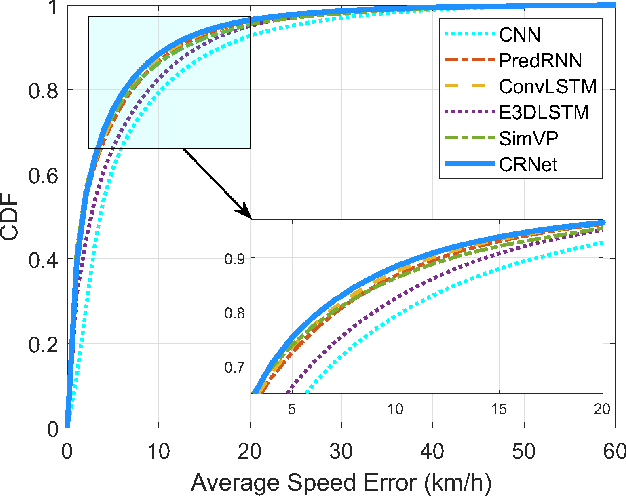

Abstract:The growing number of connected vehicles offers an opportunity to leverage internet of vehicles (IoV) data for traffic state estimation (TSE) which plays a crucial role in intelligent transportation systems (ITS). By utilizing only a portion of IoV data instead of the entire dataset, the significant overheads associated with collecting and processing large amounts of data can be avoided. In this paper, we introduce a novel framework that utilizes sparse IoV data to achieve cost-effective TSE. Particularly, we propose a novel spatial-temporal attention model called the convolutional retentive network (CRNet) to improve the TSE accuracy by mining spatial-temporal traffic state correlations. The model employs the convolutional neural network (CNN) for spatial correlation aggregation and the retentive network (RetNet) based on the attention mechanism to extract temporal correlations. Extensive simulations on a real-world IoV dataset validate the advantage of the proposed TSE approach in achieving accurate TSE using sparse IoV data, demonstrating its cost effectiveness and practicality for real-world applications.
Personalized Federated Domain-Incremental Learning based on Adaptive Knowledge Matching
Jul 06, 2024



Abstract:This paper focuses on Federated Domain-Incremental Learning (FDIL) where each client continues to learn incremental tasks where their domain shifts from each other. We propose a novel adaptive knowledge matching-based personalized FDIL approach (pFedDIL) which allows each client to alternatively utilize appropriate incremental task learning strategy on the correlation with the knowledge from previous tasks. More specifically, when a new task arrives, each client first calculates its local correlations with previous tasks. Then, the client can choose to adopt a new initial model or a previous model with similar knowledge to train the new task and simultaneously migrate knowledge from previous tasks based on these correlations. Furthermore, to identify the correlations between the new task and previous tasks for each client, we separately employ an auxiliary classifier to each target classification model and propose sharing partial parameters between the target classification model and the auxiliary classifier to condense model parameters. We conduct extensive experiments on several datasets of which results demonstrate that pFedDIL outperforms state-of-the-art methods by up to 14.35\% in terms of average accuracy of all tasks.
 Add to Chrome
Add to Chrome Add to Firefox
Add to Firefox Add to Edge
Add to Edge